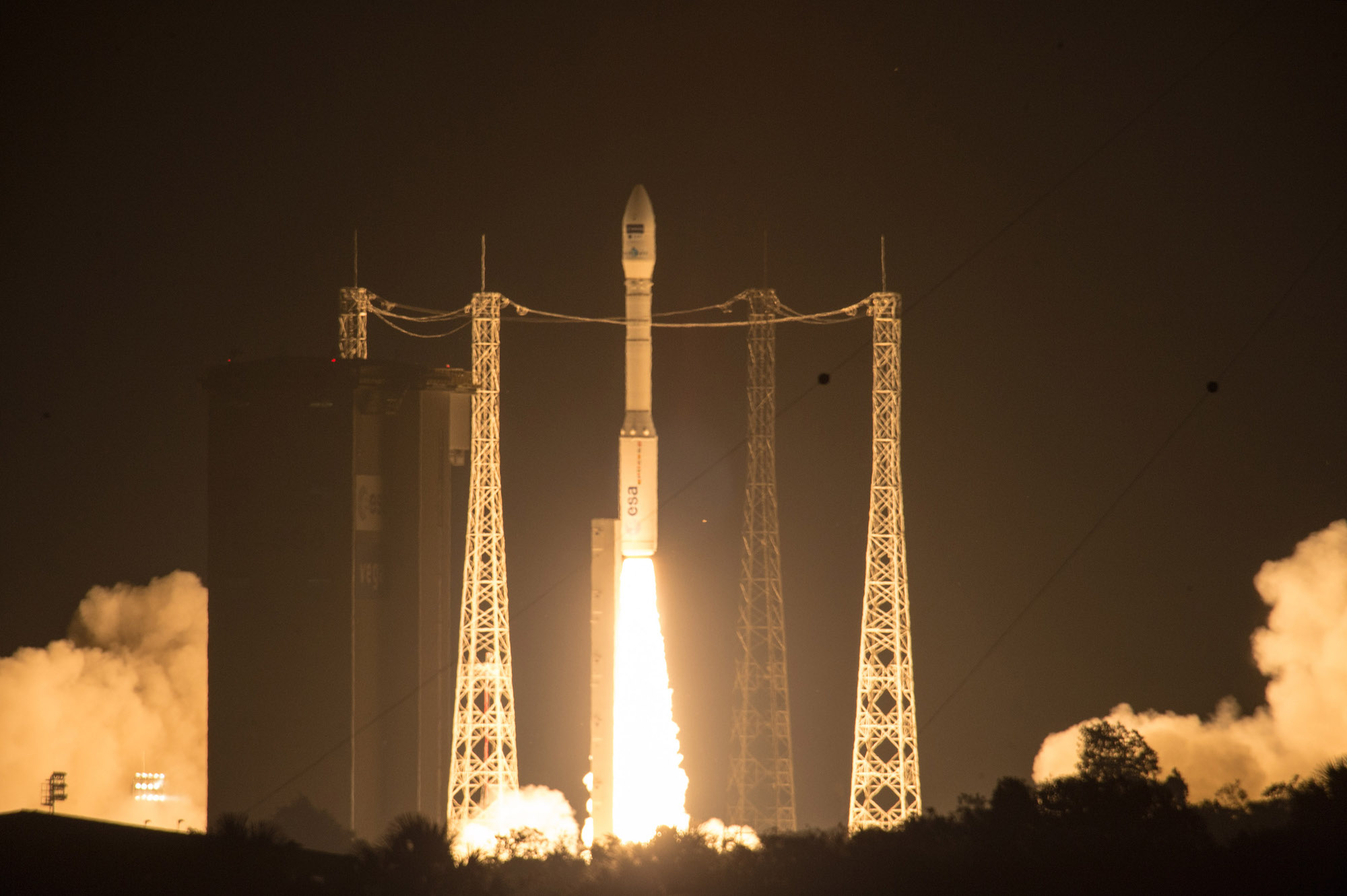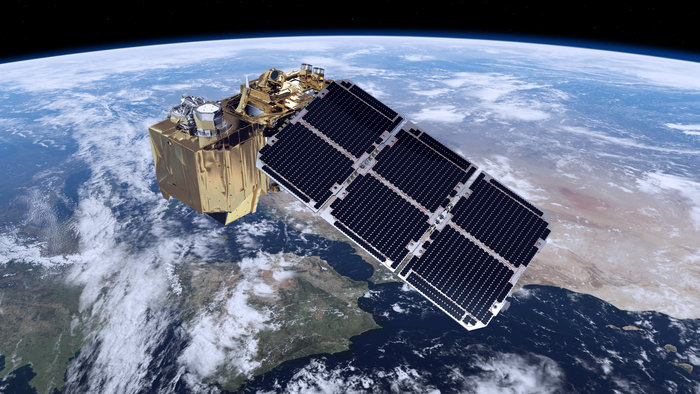
A new satellite to monitor crops, pollution and the growth of cities blasted off Monday from a tropical spaceport in French Guiana, adding another piece to Europe’s multibillion-dollar fleet of spacecraft tasked to track Earth’s ever-changing environment.
The Sentinel 2A satellite, the second of more than a dozen European environmental sentinels slated to launch in the coming years, lifted off at 0151:58 GMT Tuesday (9:51:58 p.m. EDT Monday) from the Guiana Space Center on the northern coast of South America.
Riding a 10-story solid-fueled Vega launcher, the 2,500-pound craft fired into the night sky over the jungle space base, heading north for a polar orbit designed to carry the satellite over the entire planet.
The Vega rocket’s three Italian-made solid rocket motors boosted the satellite for nearly seven minutes, then a Ukrainian fourth stage burning hypergolic hydrazine fuel ignited two times to inject Sentinel 2A into a nearly circular orbit about 488 miles — 786 kilometers — above Earth at an inclination of 98.5 degrees.
Flying above a ground station in Perth, Australia, the launcher’s upper stage released Sentinel 2A about 55 minutes after liftoff, and pre-programmed commands aboard the spacecraft started procedures to extend the satellite’s power-generating solar panel and stabilize its pointing to ensure the solar cells could receive sunlight.
The satellite’s passage over a communications antenna in Antarctica a few minutes later confirmed Sentinel 2A weathered Monday night’s launch in good condition.
The European Space Agency and Arianespace, which conducted the launch, declared the mission a complete success.
Sentinel 2A’s launch was the fifth flight of the Vega rocket, an Italian-led program with the backing of ESA tailored to loft small satellites into low Earth orbit.

Before 2015, the Vega rocket only launched once per year. But Monday’s flight was the second Vega launch of the year, and one more mission is scheduled for November to send up ESA’s LISA Pathfinder probe to measure gravitational waves.
Arianespace aims for at least three Vega launches annually over the next few years. Together with Arianespace’s larger Ariane 5 and Soyuz boosters, the company plans up to seven more launches before the end of 2015.
“Vega is keeping up with its promises, and the most demanding customers are not mistaking them: Vega’s backlog has now reached 10 launches, six of them being for the benefit of export customers in the field of Earth observation,” said Stephane Israel, Arianespace’s chairman and CEO. “So, let me thank again our prime contractor, ELV, a company jointly owned by Avio and the Italian Space Agency, ASI, for delivering such a fine product — symbol of the Italian excellence in the field of launch vehicles.”
Sentinel 2A is kicking off a seven-year mission, joining the European Union’s Copernicus environmental surveillance network to measure changes to Earth’s land masses, oceans and atmosphere.
“We have a mission,” said Volker Liebig, head of ESA’s Earth observation programs. “We have a Sentinel 2 mission. We have two Sentinels now in orbit, and this is due to many who have cooperated extremely well.”
ESA manages the satellites and launches for the Copernicus program on behalf of the European Commission, the EU’s executive body.
The first Copernicus satellite — named Sentinel 1A — went up in April 2014. The Sentinel 1 series carry radars, while the Sentinel 2 satellites host powerful color cameras to image forests, crops, cities and rivers.
“Sentinel 2A is the fruit of European technological and industrial excellence,” said Elzbieta Bienkowska, European Commissioner for the internal market, industry, entrepreneurship and SMEs. “It will deliver data that are needed to provide precise and reliable information about our environment and European citizens’ security.”
An identical spacecraft is set for launch in September 2016. With two Sentinel 2 platforms in orbit, users will be able to glimpse the same location on Earth every five days.
Built by Airbus Defense and Space, Sentinel 2A could last longer than its seven-year design life. It carries enough fuel to operate for 12 years, according to Francois Spoto, ESA’s Sentinel 2 program manager.
The first picture from Sentinel 2A’s camera should be transmitted to Earth within a week of launch, Spoto said, but it will take three months to finish calibrating the instrument and declare the satellite fully operational.
Later Sentinel missions will focus on oceanography and the atmosphere.
“We have an Earth observation system that’s falling into place that has no equivalent on the planet,” said Philippe Brunet, director for space policy and head of the Copernicus program at the European Commission. “An Earth observation system for a political organization like the commission — what does that mean? This is for decision support, also for crisis management, (and) it’s an aid for citizens. That means more growth. That also means more jobs, and above all, it’s a bet on the future because increasingly we’re going to depend on space.”
European governments plan to spend up to $10 billion on the Copernicus network through 2020, making it the largest civilian-run Earth observation program in the world and Europe’s most expensive space program.
“This is an operational spacecraft,” said Francois Spoto, ESA’s Sentinel 2 program manager, in an interview before the launch. “This is not considered a scientific spacecraft, even though science will benefit from the mission.”
Sentinel 2A’s camera can see in 13 colors and paints a swath 180 miles (290 kilometers) wide as the satellite speeds around Earth.
“It has 13 spectral channels to analyze 13 different nuances of colors when taking an image of Earth, and a spatial resolution which may seem relatively modest — 10 meters (33 feet) in the current case — is actually quite high given the number of channels and the width of the swath of the imagery,” Spoto said.
The color imagery will beam back to Earth via a laser link with a communications terminal on a satellite in geostationary orbit.
The satellite continues observations made by France’s Spot series of Earth imaging spacecraft and the U.S. Landsat missions.
Europe will freely distribute data from the Copernicus satellites, a key tenet of the program.
“Constellations of satellites monitoring the Earth with radar systems, looking at the atmosphere, looking at the oceans, looking at the land change, they will assure Europe with the data it needs at least for the next 20 years, and combined with the meteorological systems, this is a very powerful and essential tool,” said Mark Doherty, head of ESA’s Earth observation exploitation development division and chief of the agency’s initiative for climate change.
The next Arianespace launch is scheduled for July 8, when an Ariane 5 rocket will lift off with the Brazilian Star One C4 communications satellite and MSG 4, a weather observatory for Europe.
European officials plan the next Copernicus program launch later this year, when Sentinel 3A will go up on a Russian Rockot booster to extend the network’s reach into ocean observations.
Email the author.
Follow Stephen Clark on Twitter: @StephenClark1.



